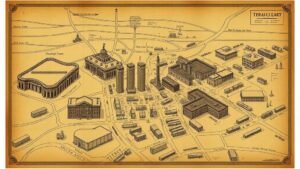Tracing Early Water Filtration Systems for Urban Infrastructure Relics
Introduction
Water filtration has been a critical factor in urban infrastructure since ancient civilizations. The desire to provide safe drinking water led to innovations in filtration techniques and systems. This article explores early water filtration systems, tracing their historical context, technological advancements, and the impact they have had on modern urban infrastructure. focus will be on systems employed in pivotal cities such as Rome, the Indus Valley, and ancient Greece.
Historical Context of Water Filtration
The quest for clean water has existed for millennia. Ancient civilizations developed various methods to improve the quality of water, ensuring public health and safety. Archaeological findings suggest that some of the earliest water filtration techniques date back to around 2000 BCE in the Indus Valley.
The Indus Valley Civilization
The Indus Valley civilization, covering parts of present-day Pakistan and northwest India, developed an extensive network of drainage and water management systems. Techniques included the use of sand filtration, which was a rudimentary yet effective method of filtering water, removing impurities before it reached inhabitants. Evidence of these filtration systems can be found in excavated urban areas such as Mohenjo-Daro and Harappa.
Ancient Greece
In ancient Greece, water quality was imperative to the health of citizens. The Greeks utilized both clay and charcoal to filter water. Notably, in the 5th century BCE, Hippocrates described the use of a linen cloth to strain impurities, laying the groundwork for more advanced techniques in later periods. The construction of aqueducts further emphasized the importance of clean water, exemplifying an understanding of water transport and storage.
The Roman Empire’s Innovations
By the 1st century CE, the Roman Empire had mastered the art of water engineering. Romans implemented sophisticated aqueduct systems which often included rudimentary filtration techniques. For example, the Aqua Marcia, completed in 144 BCE, employed settling tanks that allowed sediments to accumulate and subsequently be removed. This method significantly improved water clarity and quality.
Technological Advancements
Over time, the methods and materials used in water filtration evolved in response to urbanization and increasing population density. By the Middle Ages, filtration systems saw further development, incorporating natural materials such as charcoal and sand.
Medieval Innovations
In medieval Europe, advancements in water filtration included the introduction of slow sand filters, which utilized layers of sand and gravel to filter out pathogens. Documented evidence from the 12th century indicates that these systems were utilized in monasteries, signifying an early acknowledgment of water sanitation and health.
19th Century Developments
The Industrial Revolution marked a significant turning point in water filtration technology. With rapid urban growth came a greater need for reliable water sources. The 19th century saw the implementation of municipal filtration plants, starting with the first documented plant in 1829 in London, which employed a process now recognized as rapid sand filtration.
Impact of Early Water Filtration Systems
The early developments in water filtration not only influenced public health but also laid the foundation for modern water treatment practices. reduction of waterborne diseases such as cholera and typhoid fever in urban areas can be directly tied to these developments. In the United States, the establishment of public health systems in the late 19th century can be traced back to earlier filtration practices.
Statistical Evidence of Public Health Improvement
Research indicates that the introduction of municipal water filtration systems in the late 1800s contributed to a 50% decrease in mortality rates due to infectious diseases related to water. For example, cities like Boston and New York experienced profound health improvements following the adoption of such systems.
Conclusion
Tracing the evolution of water filtration systems reveals a profound legacy that continues to influence public health and urban infrastructure today. historical practices employed by ancient civilizations paved the way for modern innovations that safeguard water quality in urban environments. Continuing to study these relics not only sheds light on our past but can inform future advancements in water treatment technology.
Actionable Takeaways
- Recognize the importance of historical water filtration methods in shaping current practices.
- Advocate for the preservation of infrastructure relics that demonstrate early engineering and health significance.
- Encourage modern urban planning to integrate sustainable water management techniques inspired by historical practices.


